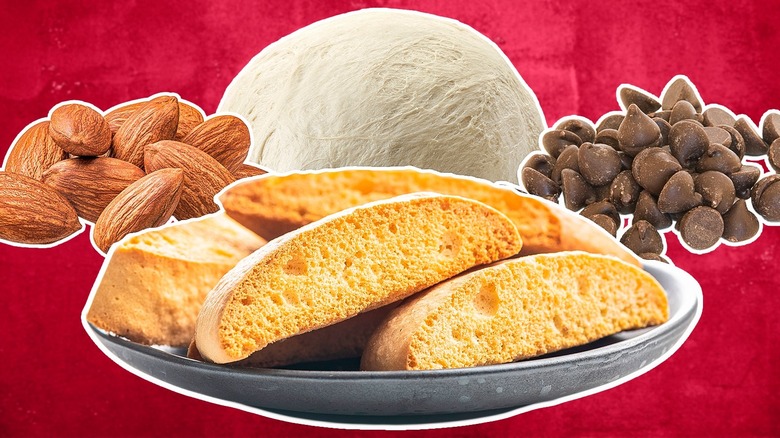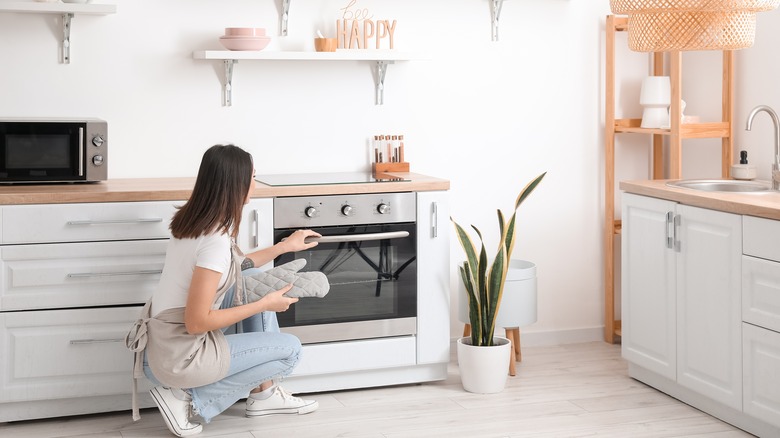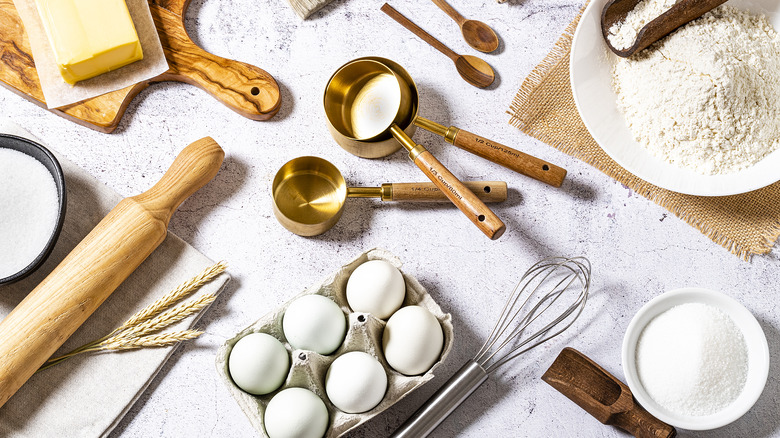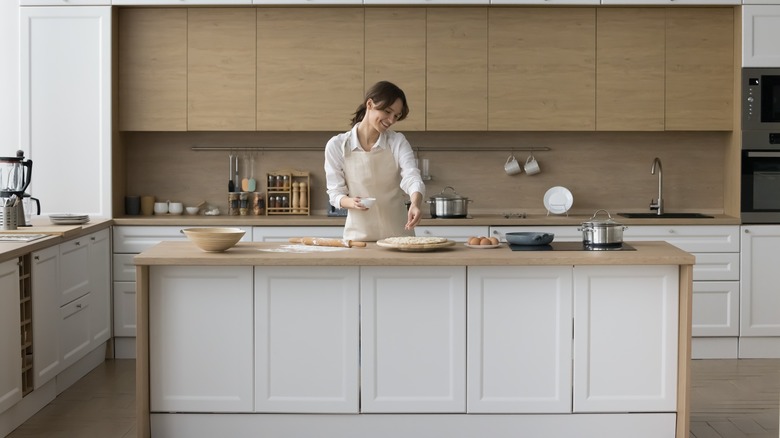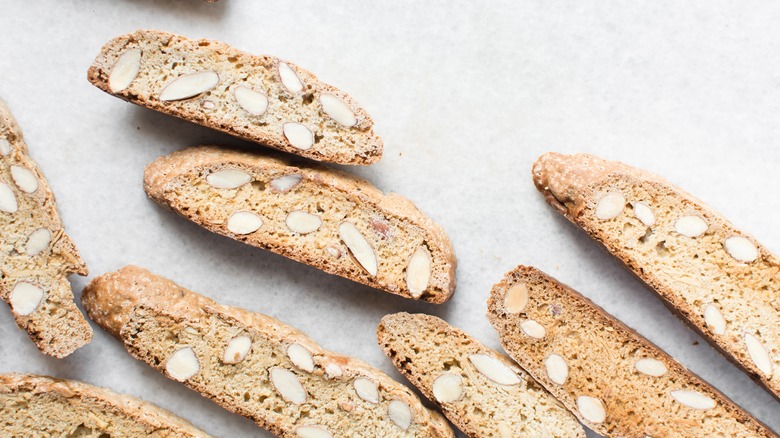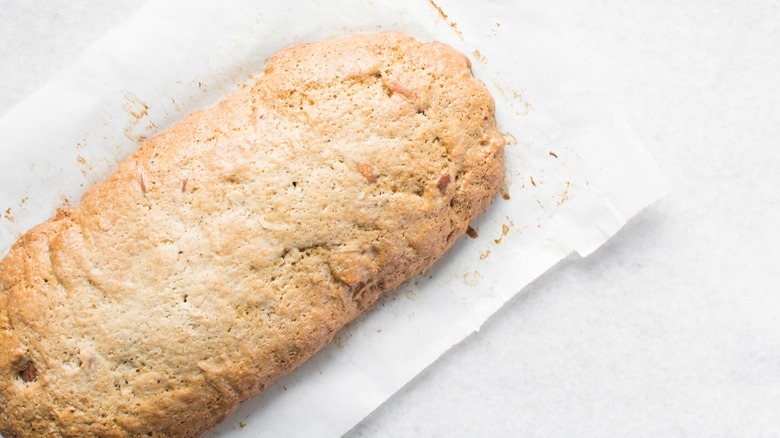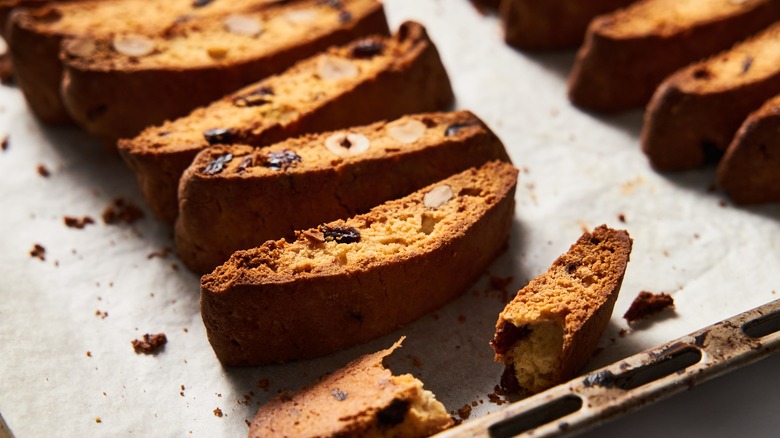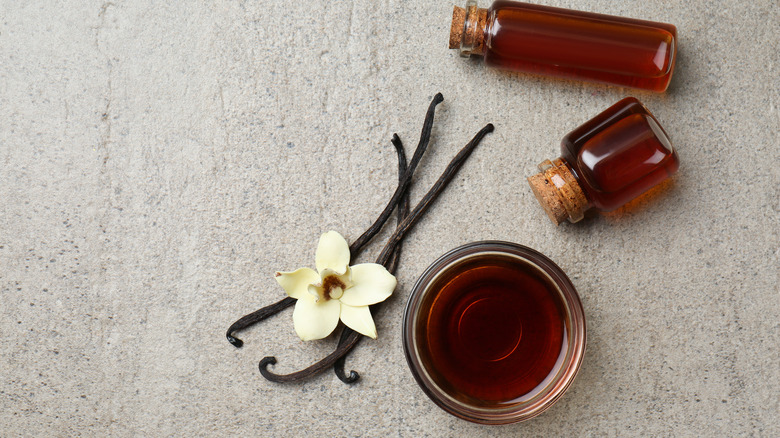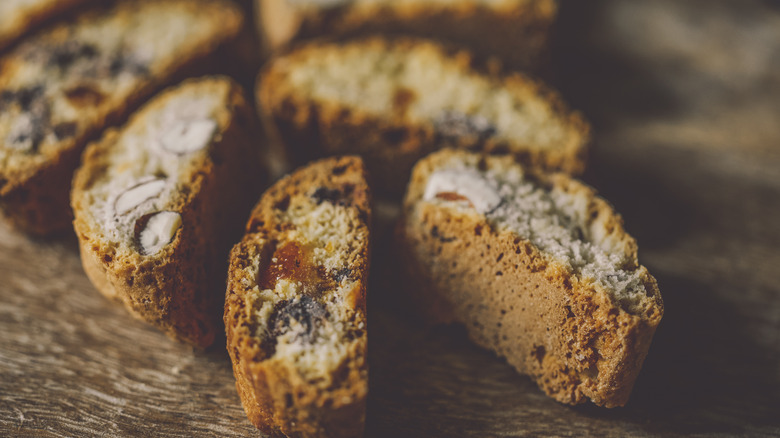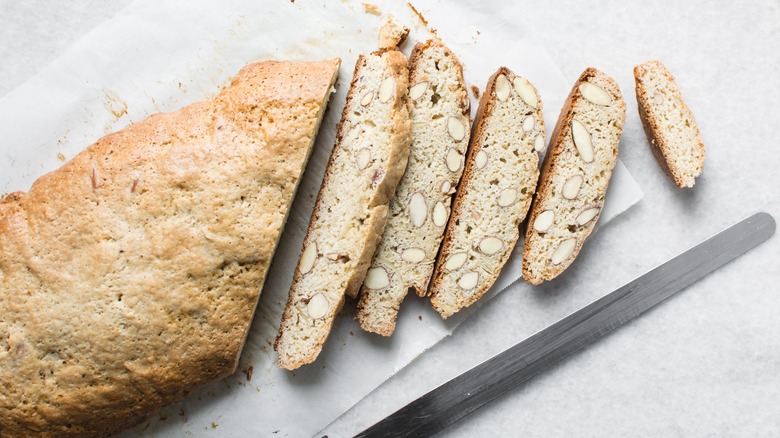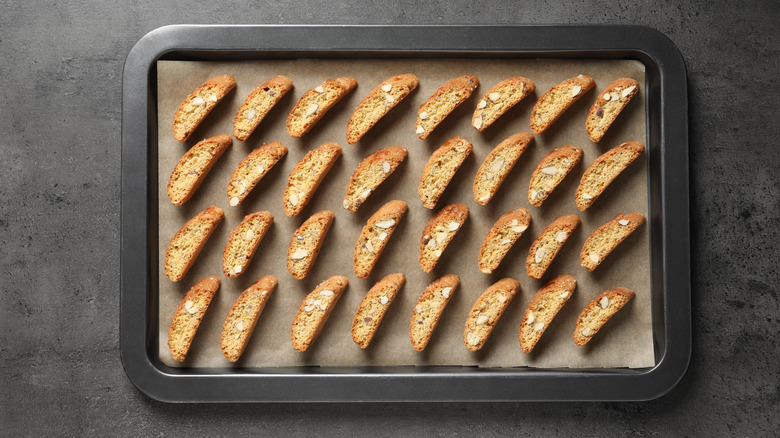11 Mistakes To Avoid When Making Biscotti From A Lifelong Baker
Baking can be a comforting practice. I grew up baking with my mom and grandma, and they made a tradition out of the experience, which made it even more special. My grandma taught me how to make biscotti, and this became a passion of mine. Biscotti, which means twice cooked, are Italian biscuit cookies that, true to their name, are typically baked twice and feature ingredients like almonds. My grandma shared different tricks with me on how to create a successful bake that I often use in my own biscotti baking company today.
Now, the family memories and excitement of creating a delicious dessert are great, but I'd be remiss not to state that baking can be hard. I started my biscotti business in 2021 and throughout these last few years, I've learned a lot and have made my fair share of mistakes along the way. Baking is a science experiment, and if one step or ingredient goes wrong, it can impact the end result very quickly. Sometimes, you bake once perfectly, and the next time, it just does not go as planned. Watch any episode of The Great British Baking Show, and you'll see this.
Biscotti does not take long to bake and can become a favorite in your cookie roster. I'm here to share some past mistakes I've made and how to avoid those when you're baking this Italian favorite.
Not considering your oven type and temperature
I recommend following a recipe when you start making biscotti in order to understand what ingredients are used and the amounts needed. However, when you start the baking process, it's important to pause even before turning on the oven. Recipes will give a standard temperature for the biscotti to cook at, normally good for whatever type of oven you have.
However, if you have a convection oven or plan to use that setting on your oven, it's likely the temperature will need to be changed. Convection ovens cook food faster. This is a great alternative to thermal ovens, as convection allows the heat to move throughout the air, ensuring food is cooked more evenly. This can be a huge bonus since it can mean that your food cooks faster. With biscotti, this is essential to keep in mind.
Biscotti are baked in logs. These logs are formed with a larger amount of dough, which is later cut into individual cookies. If one tried to bake the biscotti logs at the recommended temperature in a convection oven, most likely, the outside of the biscotti would cook quickly, but the inside with remain raw. I know this from personal experience. So, what is the solution if you are baking with a convection oven or setting? You'll want to take 25% off the recommended oven temperature listed in the recipe to ensure the inside of the biscotti log has more time to bake properly.
Opening the oven door too frequently
I will be the first to admit that I am an anxious baker. I am always tempted to open the oven door and see how the biscotti are baking. What if, this time, the biscotti cooks more quickly than last time? It's good to be aware of the bake and be checking occasionally on how the cooking process is going. I even recommend flipping the baking sheet mid-bake to ensure the logs are evenly cooking, which offers an opportunity to take a look at how far along the biscotti is. Yet opening the oven door multiple times is not the way to do it. Any time the oven is opened, it lets the heat out. This is taking heat away from those biscotti logs that seriously need it.
To avoid this mistake, one solution is to use the light feature on the oven. Many ovens have a light that you can turn on, which will help one more clearly see the biscotti in the oven and how it's cooking without risking opening the door. Don't have the light? Commit to doing only a quick check once or twice, opening the oven for a moment; it should not have a big impact. However, it's important to be brief — any longer can impact the overall cooking of the biscotti.
Going rogue with ingredient quantities
When following a recipe, it's important to follow each step accurately. Baking is like chemistry, and the amounts of ingredients listed have been tested and proved to accurately create a successful bake. Will adding an extra few chocolate chips affect the entire bake of your biscotti? Not likely. However, you want to be as consistent as possible with the recipe. It's also best to avoid any ingredients on top of the biscotti log, as they will cook more quickly being so close to the surface. Save these toppings until the biscotti has fully cooked.
If one adds more flour than the recipe calls for, the resulting biscotti will most likely take longer to bake, which can impact the overall consistency and make them very dry. Throwing in some extra baking powder can cause the biscotti dough to rise too quickly, losing the accurate texture. This can also affect the taste of the biscotti, making them more bitter and way less appetizing.
Mistakes happen, and there are solutions to remedy them without throwing away the batch you are working on. For example, if you add too much flour, it's important to add extra fat or liquid to correct this. Biscotti typically is not made with milk, so another step of this solution is to add an extra egg yolk. If a remedy like this doesn't work, the great news is that it can be quick work to restart the dough.
Doubling the recipe without scaling correctly
Many biscotti recipes call for one or two dozen cookies. If you are preparing for an event and want to double the recipe, it's important to plan out the process. With the ingredients, typically, you can double or triple the amounts shown on the recipe to give you the new amount of biscotti you are looking to bake. The planning really comes in with the equipment and baking.
Before kicking off the process and starting to mix the eggs and oil, make sure the baking equipment you are using can handle this larger number of ingredients. I've had the moment where there is dough coming out of the bowl as it's mixing because I thought I could bake a larger quantity with the same tools I use for a single batch. The amount of flour on my kitchen floor made me think twice next time. This also can make it difficult for ingredients to fully combine. If you don't have larger bowls, bake in one batch at a time.
Similarly, it's important to consider the amount of biscotti dough being cooked at one time in the oven. The more you add, the more dough there is to cook, which can lead to uneven bakes. I always cook my biscotti on the lower rack, so I recommend working in stages for large recipes: bake one batch at a time, and while the first biscotti are cooking, prepare the second.
The toppings or liquid in your dough are too heavy
Yes, it is important to follow a recipe completely, but that should not take away from the creative process. If the recipe calls for chocolate chips, but you want to try using butterscotch chips instead, go for it. If you are taking a recipe and following all of the base ingredients but want to mix up the flavor and add a hazelnut spread, this is your moment! The only caveat with adding in additional or different ingredients is that doing so can affect the bake of your biscotti.
In this science experiment, make sure the texture of the dough doesn't change with more toppings. Adding too many chocolate chips could take over the dough and affect the baking time. This also could affect the taste, overpowering the actual biscotti cookie flavor. Adding liquid, like coffee, can change the consistency of the dough.
Too much liquid will take away from the balance between the flour and baking powder and make the resulting dessert look more like a pancake. If you do want to add that coffee taste to the biscotti, consider coffee extract instead. This will be a powerful flavor that requires far less liquid. You can also try a stronger flavor of coffee, like coffee concentrate. If going this route, add a small amount of concentrate at a time and keep an eye on the texture. If you see the dough becoming softer, you'll want to stop adding additional liquid.
The biscotti log isn't in the right shape and size
As mentioned earlier, biscotti cookies are not baked individually but as logs that you then chop to create that classic biscotti shape. Because these logs contain a lot of dough, it's key to shape them correctly so that they bake well. It's best to mold the dough so it looks like a long rectangle or oval. You do not want the dough thicker than 1-inch tall all around. Be sure to check and ensure the dough is the same width throughout the entire log so that it bakes evenly.
Most commonly, biscotti is baked twice. The log of dough is baked first, and then once this is cooled, the biscotti log is chopped into individual cookies. These cookies are then put back in the oven for additional baking. Because of this, the cookies have plenty of time to bake, but it's still best to avoid raw dough resulting from the first bake.
Forgetting to flip the biscotti on their second bake
Here is where the "twice baked" meaning of biscotti comes into play. If you are baking traditional biscotti, you will be putting your cookie creation in the oven twice. After letting the log cool, it's time to slice the log into ½ to 1-inch wide biscotti cookies. Depending on how long the log is, you will most likely have a dozen or so biscotti. Once the cookies are ready, you will distribute them evenly on the baking sheet, placing them on their sides and putting the baking sheet back into the oven.
Unlike the log that bakes in place, it's key to flip these individual biscotti about half way through their second bake. If the recipe calls for a 10 minute total bake for the second round, you will want to flip the biscotti over 5 minutes into baking. While biscotti are meant to be crisp cookies, the goal is not to make them dry. If the biscotti are not flipped, they are more likely to lose more moisture and bake unevenly.
Too much extract is overpowering your dessert
An extract can be one's best friend when baking biscotti. This liquid brings incredible, strong flavor to any dessert. With biscotti, you will typically see recipes call for anise extract or vanilla. If this is for almond biscotti, then almond extract will also be on the ingredient list. While these can be more pricey ingredients, vanilla extract can last for years, so once you have it in your kitchen, you know you can keep it for future baking.
While staying with the ingredient amounts in a recipe is always a good suggestion, for extracts, it is a hard rule. Anise extract has a powerful, licorice-like flavor. The perfect amount can make this dessert delicious, but be careful before adding an additional teaspoon or two. This extract and licorice flavor will take over the taste of the cookie. The bitterness can be very strong and ruin a batch of biscotti. This is the same idea with almond extract. Biscotti with almond extract is one of my personal favorites, but these cookies require just a teaspoon or two per batch, as this is similarly a very strong flavor. Stick with the recipe, and then you also have more extract saved for a future bake.
Waiting too long to check on how the biscotti baked
Recipes offer a recommended baking time. All of this is true: following a recipe is important, there is a good chance that the biscotti will take the recommended time to bake, and you should be cautious about opening the oven door too often. Still, I would suggest not waiting until the recipe's end time to take a look at how the biscotti logs are baking. As mentioned, opening the oven door multiple times is not great for the biscotti, as it lets needed heat escape. If you have an oven light, this is a good way to check on the biscotti. If you do not have this feature, save opening the oven to check on the bake until closer to the end cook time of the biscotti recipe.
Let's say the recipe recommends 20 minutes for the logs to bake. At 15 minutes, take a look at the biscotti logs. If you are already seeing browning around the edges of the logs, they may already be done or only need an additional minute or two. As mentioned, changes can be due to your oven type, especially if you are using a convection setting. If you wait to look at the biscotti until the 20 minutes are up, there can be a that they are already too brown or even burnt.
Cutting the biscotti before it cools
When taking the biscotti out of the oven, be sure to let the logs sit and cool fully before chopping the biscotti into individual cookies. When biscotti logs come out of the oven, they are still cooking. Leaving them on the baking sheet until they cool allows them to continue to bake a bit and avoid the risk of the dough being raw.
If you try to start slicing the biscotti before they cool, you'll notice that the dough is still soft, and it's very likely that the biscotti will break apart as you cut into the log. If the sliced biscotti cookie was not fully cooked, it will still cool but will not be the ideal consistency. Plus, you don't want to risk burning yourself by trying to touch the biscotti logs so quickly after they have been in an oven. I usually give the biscotti over an hour to cool before moving on to the next step.
Not using parchment paper
The day I discovered parchment paper for my baking was a really good day. This is a tool that helps you when it comes to keeping your biscotti whole. When you go to remove biscotti logs or individual biscotti from a baking sheet with parchment paper, the cookies come off the sheet smoothly. You won't be scraping the pan trying to remove the whole log. Because biscotti logs can be larger and take over quite a bit of the baking sheet, parchment paper is especially helpful, as there is more of a risk of breaking apart without the paper.
What about other options like wax paper or aluminum foil? While wax paper and parchment paper might seem similar, there is a big difference. Wax paper cannot handle high temperatures and be exposed to direct heat from an oven. You can use aluminum foil, but it is not made of a nonstick material. You would want to spray the aluminum foil with cooking spray to ensure your biscotti does not stick. Parchment paper, on the other hand, is nonstick and does not require any cooking spray.
If, after removing the biscotti, there is little to no residue left over on the parchment paper sheets, you can save them for future use. That also makes parchment a cost-effective option. Usually, the worst part of baking is the cleaning afterward, and when using parchment paper, that becomes minimal. Sounds like a win-win to me.
